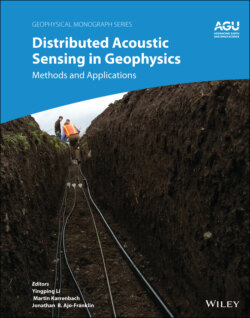Читать книгу Distributed Acoustic Sensing in Geophysics - Группа авторов - Страница 66
3.5. CONCLUSIONS
ОглавлениеThe general benefits of fiber optic DAS, such as a large number of channels and being free of power supply in the sensing area, make it more suitable for long‐distance detection (sensing) at shortest time, significant cost saving, and without a need to interrupt other activities. Thus, fiber optic DAS is increasingly being recognized as a viable alternative to downhole geophone arrays for the acquisition of borehole seismic data. To increase the SNR and eliminate the random fading of the sensing fiber, DMOF was proposed as the sensing fiber and fabricated through the UV laser light exposure. By employing the coherent detection and IQ demodulation scheme, a DMOF‐based fiber optic DAS system with a wide frequency range from 0.01 Hz to 60 kHz and an ultrahigh strain resolution of 3.4 pε/√Hz around 10 Hz was explored and demonstrated. The field zero‐offset VSP, offset VSP, and walkaway VSP tests proved that the DMOF‐DAS system can acquire borehole seismic data with good quality. Because of the benefits of the long‐distance sensing and distributed monitoring capabilities, the fiber optic DAS system can dramatically reduce the operating time required to complete a normal borehole seismic survey and can achieve much higher full well spatial sampling than current technologies. The ability to acquire borehole seismic data in a producing well without the need to disrupt production also offers significant benefits to the operators.
